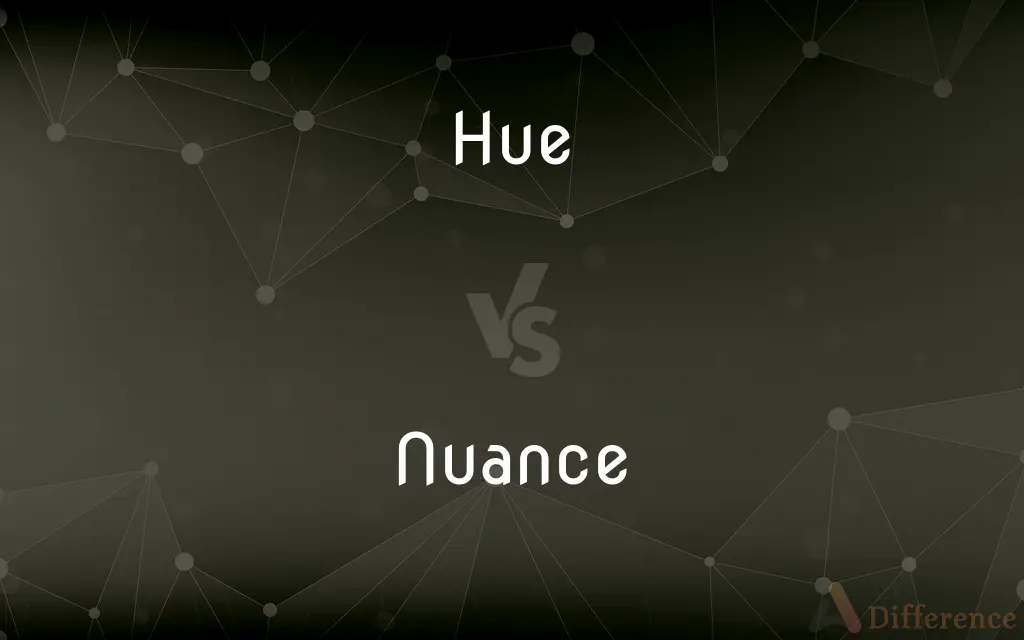Hue vs. Nuance — What's the Difference?
By Maham Liaqat & Fiza Rafique — Updated on March 19, 2024
Hue refers to the specific color itself within the color spectrum, central to color theory; nuance denotes a subtle difference or variation, often within a particular hue or context.

Difference Between Hue and Nuance
Table of Contents
ADVERTISEMENT
Key Differences
Hue is a primary component of color theory, representing colors at their purest form without the addition of white or black to alter their intensity or value. It is what we commonly identify as color — red, blue, green, etc. Nuance, in contrast, refers to the subtle distinctions or variations that may exist within any given hue or aspect, highlighting the complexity and depth beyond the initial perception.
In the realm of art and design, hues are the foundation of the color palette, used to create a wide array of expressions, moods, and styles. Nuances within these hues — achieved through shading, tinting, or toning — add depth, emotion, and specificity to the visual narrative. While hue dictates the general color direction, nuance fine-tunes the aesthetic and emotional resonance.
The perception of hue is direct and categorical, allowing for clear communication and understanding in both natural and digital environments. Nuance, however, requires a more discerning eye and often conveys a level of sophistication or a particular quality that may be perceived differently by individuals based on their experiences, expectations, or cultural backgrounds.
While discussing color, hue is often used in a broad sense to classify and organize colors into families and primary components. Nuance comes into play when describing the subtle variations within these categories, such as the difference between sky blue and turquoise, which belong to the same hue family but differ in nuance.
The significance of hue lies in its ability to convey basic and universal color information, essential for foundational understanding and communication in various fields. The importance of nuance, however, lies in its ability to convey specificity, individuality, and the finer aspects of color and context, enhancing the richness and diversity of perception.
ADVERTISEMENT
Comparison Chart
Definition
A distinct characteristic of color identifying it as red, blue, green, etc.
A subtle difference or variation, especially within a color
Role in Color Theory
Fundamental aspect of color identity
Conveys subtleties and variations within a hue
Perception
Direct and clear
Requires discernment and can be subjective
Communication
Used for broad classification and understanding
Describes specific qualities and variations
Importance
Essential for basic color information and organization
Enhances richness and individuality in interpretation
Compare with Definitions
Hue
Basic color category.
Artists often start with primary hues to mix their desired colors.
Nuance
Adds depth to visual elements.
The photographer captured the nuance of light in the landscape.
Hue
Foundation of color theory.
Understanding hues is essential for anyone studying art or design.
Nuance
Enhances perception and interpretation.
Appreciating the nuance in different musical genres enriches the listening experience.
Hue
Pure color without tint or shade.
The designer chose a hue of green that mimicked nature for the logo.
Nuance
Subtle variation in color.
The nuance between the two shades of blue was barely noticeable.
Hue
Identifies color families.
The hue spectrum ranges from warm to cool colors, each evoking different emotions.
Nuance
Fine distinction in meaning or detail.
His choice of words added a nuance of sarcasm to the statement.
Hue
The attribute of color that differentiates it.
The hue of the sky at sunset shifted from blue to a vibrant orange.
Nuance
Individualizes and specifies.
The nuance in her painting style set her work apart from others.
Hue
In color theory, hue is one of the main properties (called color appearance parameters) of a color, defined technically in the CIECAM02 model as "the degree to which a stimulus can be described as similar to or different from stimuli that are described as red, orange, yellow, green, blue, purple," which in certain theories of color vision are called unique hues. Hue can typically be represented quantitatively by a single number, often corresponding to an angular position around a central or neutral point or axis on a color space coordinate diagram (such as a chromaticity diagram) or color wheel, or by its dominant wavelength or that of its complementary color.
Nuance
A subtle or slight degree of difference, as in meaning, feeling, or tone; a gradation.
Hue
The property of colors by which they can be perceived as ranging from red through yellow, green, blue, and violet, as determined by the dominant wavelengths of the light being reflected, transmitted, or emitted. See Table at color.
Nuance
Expression or appreciation of subtle shades of meaning, feeling, or tone
A rich artistic performance, full of nuance.
Hue
A particular gradation of color; a shade or tint.
Nuance
To treat or consider with nuance; give nuances to
New information that nuanced their understanding of the situation.
Hue
Color
All the hues of the rainbow.
Nuance
A minor distinction.
Hidden nuances
Hue
Appearance; aspect
A man of somber hue.
Nuance
Subtlety or fine detail.
Understanding the basics is easy, but appreciating the nuances takes years.
Hue
A color, or shade of color; tint; dye.
Nuance
(transitive) To apply a nuance to; to change or redefine in a subtle way.
Hue
The characteristic related to the light frequency that appears in the color, for instance red, yellow, green, cyan, blue or magenta.
In digital arts, HSV color uses hue together with saturation and value.
Nuance
A shade of difference; a delicate gradation.
Hue
(figuratively) A character; aspect.
Nuance
A small difference in meaning, significance, or expression.
Hue
(obsolete) Form; appearance; guise.
Nuance
A subtle difference in meaning or opinion or attitude;
Without understanding the finer nuances you can't enjoy the humor
Don't argue about shades of meaning
Hue
(obsolete) A shout or cry.
Hue
Color or shade of color; tint; dye.
Hues of the rich unfolding morn.
Hue
A predominant shade in a composition of primary colors; a primary color modified by combination with others.
Hue
A shouting or vociferation.
Hue
The quality of a color as determined by its dominant wavelength
Hue
Take on color or become colored;
In highlights it hued to a dull silver-grey
Hue
Suffuse with color
Common Curiosities
How can one develop an eye for nuance?
Developing an eye for nuance involves practice, attention to detail, and exposure to a variety of contexts and interpretations.
Why are nuances important in art?
Nuances add depth, complexity, and individuality to art, allowing for more expressive and nuanced communication.
Can hue and nuance apply to aspects other than color?
Hue is specific to color, but nuance can apply to a wide range of contexts, including language, emotions, and art.
What is the main difference between hue and nuance?
Hue refers to the color itself, while nuance is about the subtle differences or variations within or beyond that color.
How do hues impact visual design?
Hues provide the basic palette for visual design, setting the mood, style, and appeal of the design.
How do hue and nuance interact in color theory?
In color theory, hue provides the foundational color categories, while nuance allows for exploration of depth, mood, and specificity within those categories.
Does the perception of nuance vary between individuals?
Yes, the perception of nuance can vary widely between individuals, influenced by personal experiences and cultural backgrounds.
How do designers use hue and nuance together?
Designers use hues to establish a color scheme and nuances to refine and differentiate the design, adding layers of meaning and emotion.
Can the same hue have multiple nuances?
Yes, a single hue can have multiple nuances, ranging in intensity, brightness, and saturation, among other qualities.
Is nuance always visible to the naked eye?
While many nuances are visible, some require more nuanced perception.
Share Your Discovery

Previous Comparison
Qualified vs. Competent
Next Comparison
Postpartum vs. PostnatalAuthor Spotlight
Written by
Maham LiaqatCo-written by
Fiza RafiqueFiza Rafique is a skilled content writer at AskDifference.com, where she meticulously refines and enhances written pieces. Drawing from her vast editorial expertise, Fiza ensures clarity, accuracy, and precision in every article. Passionate about language, she continually seeks to elevate the quality of content for readers worldwide.
















































